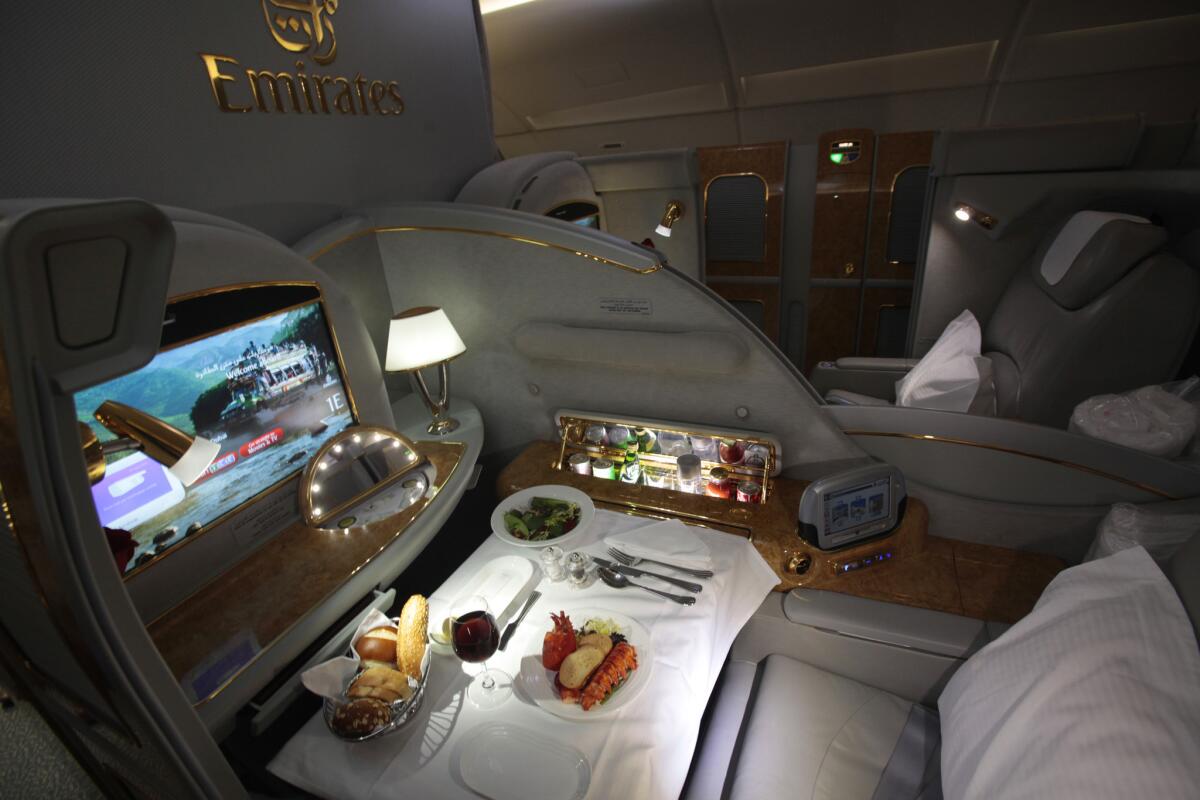How airline seating reflects income inequality

- Share via
When I flew on Aeroflot back in the mid-1990s, everyone flew what we would think of today as Economy; they were still serious about a classless society in those post-Gorbachev years, or perhaps they hadn’t quite gotten their arms around the idea of tapping the 0.1% for excess disposable income.
The potential isn’t lost on U.S. and European carriers today. They’ve been squeezing ordinary passengers into narrower seats with less legroom, so they can expand the offerings for those willing to pay extra -- Economy Plus (about as much legroom as you used to get for the lowest fares); Business Class, and Upper Crust. On international flights, the latter don’t only get cookies, but fold-down beds!
Over at the OrgTheory.net blog and Crooked Timber, sociologists Beth Berman and Kieran Healy spin a couple of neat fantasias about how today’s cabin configurations match up with income inequality in society at large. Their findings hit us where we live, having just completed a 12-hour flight from Asia in United Airlines steerage. (Preliminary finding: You can book an aisle seat and board with a neck pillow, noise-reduction headphones, and a fully-stocked Kindle, and it’s still a killer flight.)
Berman calculates that in the usual configuration for a United transatlantic flight on a Boeing 777, the richest (or highest-paying) passengers account for 21% of those on board and take up 40% of the place; the mid-level (Business Class) comprises 27% of the passenger list and takes up 20%, and the bottom 52% get 40% of the space. As in real life on the ground, the middle gets squeezed the most.
The Gini coefficient on this flight is about 0.25. Gini, you should know, is a measure of inequality ranging from 0, in which everyone gets the same income, to 1, in which one person gets it all. The Gini coefficient of the U.S. is about 0.45. In other words, that transatlantic flight is unequal, but not as unequal as American society.
“It’s not often you see such a clear visual representation of our collective acceptance of the right of a small fraction of people to consume a very disproportionate percentage of resources,” Berman writes. (Take a look at this cartoon by Keith Knight on the same topic.)
Healy picks up her ball and takes things from there, asking what an airline cabin would look like if it matched U.S. inequality exactly. So he launched “Air Gini, America’s most American airline.”
He starts with a conventional three-class layout for an Airbus A330 on an international route. (See the first accompanying graphic.) Of the 227 passengers, the 78% in Economy get 58% of the space, the 18.5% in Business get 31% of the space, and the 3.5% in First get 11% of the space.
On Air Gini, however, Economy class accounts for about 80% of the passengers--that is, everyone making less than $97,000 a year in the U.S. “Their share of total income in the U.S. is just below fifty percent,” he writes, “and so thus so is their share of the seating space.” They’re a little more cramped than in the conventional seating. “Economy Class passengers on Air Gini should expect less overhead bin space and more passive-aggressive interactions with the guy in front of them who insists on reclining his seat.”
Business class passengers are afforded only 15% of the space, down from their 30% in the conventional arrangement. These are households making $97,000-$280,000 a year, and in the air, as on the ground, they’re almost certainly grousing that they’ve been handed a raw deal compared to their expectations as members of the rising middle class.
Up front, of course, all is sunny. The eight passengers in First are luxuriating in 35% of the seating space. As you can see from the seat map (see the second graphic), they have far more space than they need or could conceivably use even if they sprawled out to the maximum on a 10-hour flight. They pay a stiff fare, or “tax,” for the privilege, and presumably spend the entire flight complaining that they’re paying more than their fair share. On the ground or in the air, some things never change.
Keep up to date with the Economy Hub. Follow @hiltzikm on Twitter, see our Facebook page, or email mhiltzik@latimes.com.
More to Read
Inside the business of entertainment
The Wide Shot brings you news, analysis and insights on everything from streaming wars to production — and what it all means for the future.
You may occasionally receive promotional content from the Los Angeles Times.











